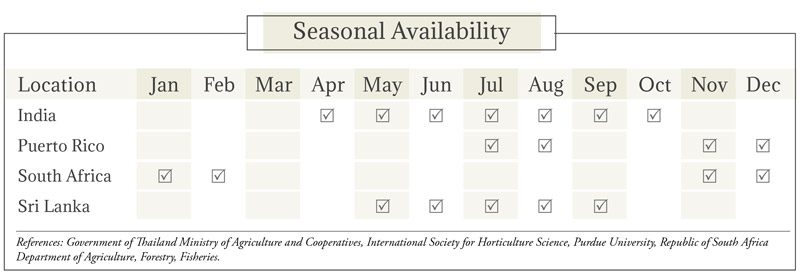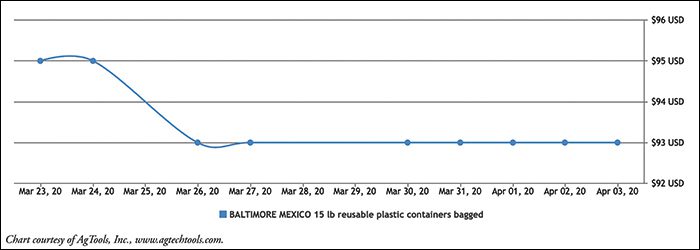Mangosteen Market Summary

Image: Samakai/Shutterstock.com
Mangosteen Market Overview
Native to Southeast Asia, the mangosteen (Garcinia mangostana) is the best known plant in the Guttiferae family of trees and shrubs. Mangosteen fruit is thought to have first been domesticated in Thailand and remains extremely popular there presently and historically, where it was even called the “queen of fruits” by European colonizers and explorers. While the small fruit has been used by traditional healers for millennia to treat many ailments from skin irritations and dysentery to other infections, there is a growing interest among scientists on whether phytochemicals derived from mangosteen fruit may have implications for cancer treatment. Appreciated for their antioxidant properties, mangosteens are hard to come by in the United States. Originally banned for import due to phytosanitary concerns, the ban was lifted in late 2007 and fruit began arriving from Southeast Asia in early 2008. The fruit is typically consumed fresh, often as a dessert, or made into a jam. Mangosteen fruit can be canned but loses some of its rich flavor in the process. In addition, the rind can be chewed or used as a dye.
Types & Varieties of Mangosteen
There is one primary variety of mangosteen, although there may be a number of unknown wild types of the fruit. On the Sulu Islands in the Philippines there is a potential distinct varietal with a larger, more acidic fruit with a thicker rind. Mangosteen trees produce a small, round fruit with a purple rind as well as a thick yellowy latex. The fruit is approximately the size of a golf ball or a bit larger, with a relatively thick pericarp, and a soft, sweet if slightly acidic aril.Cultivation of Mangosteen
An evergreen, the mangosteen tree takes a decade, on average, to begin fruiting with some trees even requiring up to 20 years. The good news is trees may produce fruit for over 100 years. For optimal production, trees require a tropical environment with no temperatures below 40°F or above 100°F as they will not be well tolerated. Seedlings will suffer below 45°F. For this reason, it is particularly challenging to grow healthy mangosteen trees in the United States, and there is no measurable production in the contiguous United States. The trees grow well in soils such as sandy loam, laterite, or clays. The seeds are not considered true seeds and mangosteen trees are also known for having a delicate taproot and do not transplant well. Trees are typically spaced 35 to 40 feet apart and can be grown in full sun or shade. Harvest begins when the fruit reaches a purplish color, with a diameter of 1.33 to 3 inches with a softened rind. The fruit is carefully harvested by hand or with a cutting pole, as it is prone to bruising and damage. Fruit must be harvested when mature as it will not continue ripening after picking.
Pests & Diseases Affecting Mangosteen
Gamboges will occur during excessive wet periods—this is when latex seeps into the fleshy part of the fruit, causing yellowing and a bitter taste. Thread blight, a fungus identified in Puerto Rico, can affect shaded trees in humid areas leading to fruits covered in webbing. Stem canker creates tube-like growths on branches and can lead to foliage and branch dieback or even the death of the tree. Asian fruit flies are a major concern for imported mangosteen fruit from Southeast Asia. As such, it was banned for import by the U.S. Department of Agriculture until 2000, and while now while allowed, must still be irradiated. Mangosteen caterpillars can cause defoliation of young trees and often feed at night, making them hard to notice. Insecticides can be applied for effective control. Small ants are known to infest the trunk and branches, preventing and/or damaging new growth. Larger creatures such as monkeys, bats, and rats are attracted to the trees and may damage fruit as it develops or when ripening.Storage & Packaging of Mangosteen
Storage for mangosteen fruit is recommended at 56°F with a shelf life of 2 to 4 weeks depending on ripeness. Relative humidity of 90 to 95% is recommended. Exposing the fruit to ethylene for 24 hours at 68°F can help with ripening, changing the color to a deeper purple and softening the edible center. Delicate fruit is easily damaged; harvest or mechanical nicks or abrasions can lead to rind and pulp hardening or translucent pulp. References: National Geographic, Purdue University, UC Davis Postharvest Technology website, University of Hawaii, University of Illinois.Grades & Good Arrival of Mangosteen
There is no grade info for passion fruit at this time. Currently, there are no good arrival guidelines published for this commodity.



